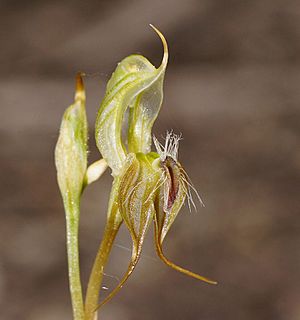Bristly rustyhood facts for kids
Quick facts for kids Bristly rustyhood |
|
|---|---|
 |
|
| Pterostylis setifera growing near Rushworth | |
| Scientific classification | |
| Genus: |
Pterostylis
|
| Species: |
setifera
|
| Synonyms | |
|
Oligochaetochilus setifer (M.A.Clem., Matthias & D.L.Jones) Szlach. |
|
The Pterostylis setifera, also known as the bristly rustyhood or sikh's whiskers, is a special type of orchid plant. It belongs to the orchid family and is found only in south-eastern Australia. This unique plant has a group of leaves that grow in a circle, like a rose, at its base. It also produces four to ten flowers that are a mix of translucent white, green, and brown. These flowers have a special lip, called a labellum, which looks a bit like an insect and is covered in long, bristly hairs.
Contents
Discovering the Bristly Rustyhood Orchid
The bristly rustyhood is a plant that grows from an underground tuber. It is a perennial plant, meaning it lives for more than two years. It's also a deciduous herb, which means it loses its leaves at certain times of the year.
What Does It Look Like?
At the bottom of the plant's stem, there's a group of leaves called a rosette. There are usually five to ten egg-shaped leaves, each about 20 to 40 millimeters (0.8 to 1.6 inches) long and 6 to 12 millimeters (0.2 to 0.5 inches) wide.
The plant grows a flowering stem that can be 150 to 300 millimeters (6 to 12 inches) tall. On this stem, you'll find two to ten beautiful, see-through white flowers. These flowers have green and light brown patterns and are about 18 millimeters (0.7 inches) long. There are also five to eight leaves wrapped around the flowering stem.
The top part of the flower, called the dorsal sepal, and the petals form a kind of hood over the central part of the flower. This dorsal sepal has a tip that points upwards, about 5 to 6 millimeters (0.2 inches) long. The lower sepals, called the lateral sepals, point downwards. They are joined together for about half their length and are much wider than the hood. These sepals have thin, thread-like tips that are 7 to 10 millimeters (0.3 to 0.4 inches) long and curve forwards.
The most interesting part is the labellum, which is the orchid's special lip. It's shaped like a spear, about 4 to 5 millimeters (0.16 to 0.2 inches) long and 2 millimeters (0.08 inches) wide. What makes it "bristly" are the 10 to 15 long hairs, up to 5 millimeters (0.2 inches) long, on each side of the labellum. There are also many short bristles on the "head" end of this lip.
You can usually see these orchids flowering from September to November.
How the Bristly Rustyhood Got Its Name
Scientists give plants official names so everyone around the world knows exactly which plant they are talking about. The bristly rustyhood's scientific name, Pterostylis setifera, was first officially described in 1985.
Who Named It?
The plant was named by three scientists: Mark Clements, I.G. Matthias, and David Jones. They described it from a plant found in the Ingalba Nature Reserve in Temora. Their description was published in a scientific journal called the Kew Bulletin.
What Does Setifera Mean?
The second part of its scientific name, setifera, comes from a Latin word. It means "bearing bristles" or "having bristles." This name perfectly describes the bristly hairs found on the labellum of the flower!
Where Does the Bristly Rustyhood Live?
The bristly rustyhood orchid can be found in different places. It often grows among rocks and in areas with mallee vegetation, which is a type of Australian bushland.
Its Home in Australia
You can find this orchid in New South Wales, south of Narrabri. It also grows in scattered groups between Wedderburn and Rushworth in Victoria. In South Australia, it is only found in the Murray botanical region. This orchid is quite rare in both Victoria and South Australia.

